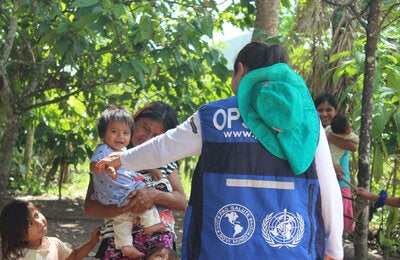
Washington, D.C., 24 September 2018 (PAHO/WHO) ‒ Health authorities of the Region of the Americas agreed today to implement a series of actions over the next five years to more effectively control the vectors that transmit diseases such as malaria, dengue, Zika, and Chagas disease. The aim of the plan is to prevent communicable diseases of this type and reduce their spread.
The populations most affected by vector-borne diseases are those living in conditions of vulnerability and far from health services. It is these populations that most frequently suffer health consequences and harm due to lack of sanitary and vector control measures.
Clarissa F. Etienne, PAHO Director
The Plan of Action on Entomology and Vector Control, presented at the 56th Directing Council of the Pan American Health Organization (PAHO), which is meeting this week in Washington, D.C., focuses on prevention, surveillance and integrated control of the vectors that transmit arboviruses, malaria, and certain neglected infectious diseases, through effective, sustainable, low-cost, evidence-based interventions.
“The populations most affected by vector-borne diseases are those living in conditions of vulnerability and far from health services. It is these populations that most frequently suffer health consequences and harm due to lack of sanitary and vector control measures,” said PAHO Director Carissa F. Etienne. “These are the populations where PAHO concentrates its efforts and where it is necessary for governments and communities to take an active role in vector prevention and control, so that, together, we can reduce the burden of these infectious diseases.”
Infectious diseases have a significant impact on public health in the Region of the Americas and throughout the world. The World Health Organization (WHO) has indicated that vector-borne diseases such as dengue, yellow fever, malaria, schistosomiasis, leishmaniasis, Chagas disease, and plague account for over 17% of infectious diseases globally, causing more than 700,000 deaths per year.
Since 2010, several major outbreaks of dengue, chikungunya, yellow fever, and Zika virus, as well as local outbreaks of malaria, leishmaniasis, Chagas disease, leptospirosis, and plague, have taken lives and strained the Region’s health systems.
The Plan of Action on Entomology and Vector Control includes five lines of action for the countries, including:
- Strengthening multisector work in various programs and sectors, in order to increase collaborative vector prevention and control efforts;
- Engaging and mobilizing local governments and communities, including health services;
- Enhancing entomological surveillance and vector control monitoring and evaluation, including insecticide resistance monitoring and management;
- Evaluating and incorporating proven or innovative approaches to vector control, and scaling them up when possible;
Providing ongoing training, not only to experts, but also public health workers, on entomology and vector control.
People’s exposure to vectors and the diseases they transmit occurs at the local level, and is often associated with factors including age group, sex, ethnicity, and profession or occupation, with inequality also playing a role.The plan of action emphasizes the need for national health and vector control authorities to plan and partner with local community organizations in order to work more effectively with the affected populations.
In terms of tools for vector control, the plan emphasizes that innovative approaches, such as bacteria-infected or genetically modified mosquitos and new insecticides should be subject to careful evaluation in pilot studies before being incorporated in the vector management arsenal.
Vector-borne diseases are infectious diseases that are spread by intermediary organisms such as mosquitoes, ticks, or rodents, which in turn transmit them to humans. They are responsible for a heavy burden of disease and mortality in the Region of the Americas, especially in countries and areas where social, economic, and ecological risk factors have been documented, and where the population lives in conditions of vulnerability.These diseases contribute to school absenteeism, increased poverty, higher health costs, and overburdened health systems, while at the same time dragging down overall economic productivity.
Data on vector-borne diseases in the Americas:
- At present, an estimated 145 million people in 21 countries of the Americas live in areas at risk for malaria. In 2017 alone, some 680,000 cases were reported in the Region. At least eight countries in the Region are working to eliminate this disease.
- Dengue epidemics have recurred in 3- to 5-year cycles in the Region of the Americas. Cases have increased since 2000; in 2017 alone, over 483,000 cases and 253 deaths were reported.
- In 2017, there were over 180,000 cases of chikungunya, a mosquito-borne viral disease that reached the Region in late 2013.
- The cumulative numbers of suspected and confirmed Zika cases in the period 2015 to and 4 January 2018 were 583,451 and 223,477 respectively, with 20 confirmed deaths and 3,720 confirmed cases of congenital Zika syndrome.
- Nearly 6 million people in the Region of the Americas still suffer the chronic effects of Chagas disease; this is especially prevalent among families whose dwellings are unprotected and in poor condition, and within some indigenous communities.
- Leishmaniasis is on the increase, with some 60,000 cutaneous and mucocutaneous cases and 4,000 visceral cases of the disease reported annually.
- At present, onchocerciasis is transmitted only in the area inhabited by the Yanomami people and along the length of the Brazil-Venezuela border.
- Lymphatic filariasis has been nearly eliminated in Brazil, and is limited to a few foci in Guyana, Haiti, and the Dominican Republic.
Active transmission of schistosomiasis is limited to a few foci in Brazil, Suriname, and Venezuela.





